Instructions
- Write your name, class and admission number in the space provided above.
- Write the date of the examination and sign in the space provided above.
- Answer all the questions in the spaces provided.
- You may be penalized for wrong spelling especially technical terms.
For Examiner’s Use Only
|
Question |
Maximum Score |
Candidate’s Score |
|
1-29 |
80 |

QUESTIONS
-
- State the contents of lysosomes. (1 mark)
- State the functions of the contents named in (a) above. (2 marks)
- What is cell specialization? (1mark)
- It was found that during germination of bean seeds, 9.2 cm3 of carbon IV Oxide was produced while 9.0 cm3 of oxygen was used up.
-
- Calculate the respiratory quotient of the reaction:- (2 marks)
- Identify the substrate being metabolized. (1mark)
- In which part of the cell does glycolysis occur? (1 mark)
-
- How is the tracheal system adapted to its function (3marks)
- Name two sites where gaseous exchange takes place in terrestrial plants. (2marks)
- The experiment illustrated below was set up to investigate a certain physiological process using a raw potato tuber
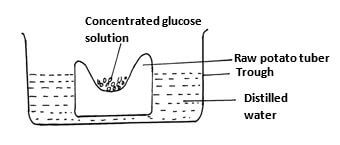
- Suggest a possible physiological process that was being investigated. (1 mark)
- Explain the results obtained in the above experiment after a few hours (3 marks)
- State the observations that would have been made if the experiment was repeated using boiled potato. (2 marks)
- State the end products of anaerobic respiration in: - (2marks)
- Animals
- Plants
- State two properties of the cell membrane (2marks)
- State two guidelines that should be followed when typing of scientific names (2marks)
- State two roles of luteinising hormones in female reproduction. (2marks)
- The diagram below shows a cross section of a plant stem.
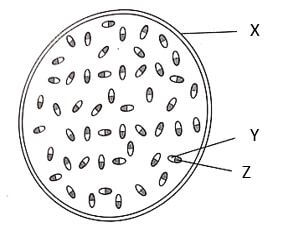
- State the class of the plant from which the organ was obtained (1 mark)
- Name the parts labeled X Y and Z (3 marks)
X …………………………………………………………………………………………
Y ………………………………………………………………………………………...
Z ………………………………………………………………………………………...
- What are the causative agents for the following sexually transmitted diseases? (2marks)
- Gonorrhoea
- Syphilis
-
- What is meant by the following terms as used in ecology : (2marks)
- Population
- Carrying capacity
- During an ecological visit to maasai mara students were able to see antelopes, lions, vultures, and pastoralists grazing their cattle. Construct a food chain with four consumer levels ending with the vulture to illustrate the energy flow in the ecosystem. (2marks)
- What is meant by the following terms as used in ecology : (2marks)
- Give three reasons why plants have not evolved complex excretory organs. (3marks)
- State one adaptation of the xylem vessels to its functions. (1marks)
- State three factors that increases the rate of diffusion. (3 marks)
- The diagram below represents a certain plant,study it and answer the questions that follow
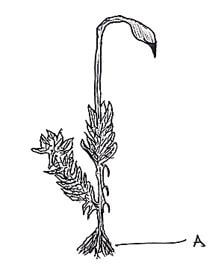
-
- Name the division to which the plant belongs (1marks)
- The plant only survives in wet areas. Give a reason (1marks)
- What is the function of part labeled A (1marks)
-
- Give the roles of each of the following important excretory products in plants (3marks)
- Quinine
- Colchicine
- Papain
- During a medical examination, a patient presented with the following symptoms, passing of large amounts of urine which when tested contained a lot of glucose.
- What hormone was deficient in the patient (1mark)
- What disease was the patient suffering from (1mark)
- State three characteristic features used to classify members of phylum Arthropoda (3marks)
- The graph below shows the effect of substrate concentration on the rate of enzyme reaction.
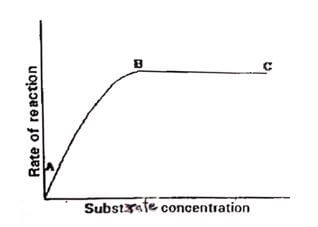
- Account for the shape of the graph between A and B (2marks)
- How can the rate of reaction be increased after point B? (1mark)
- State one other factor that affects the rate of enzyme reaction. (1mark)
-
- The diagram below shows stage during cell division.
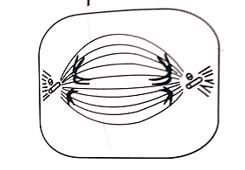
- Identify the stage of cell division in the diagram above (1 mark)
- Give a reason for your answer in (i) above (1mark)
- How are the spongy mesophyll cells adapted to their functions? (1mark)
- The diagram below shows stage during cell division.
- Name one cofactor and one co-enzyme required for a blood clotting process to be normal.
- Co-factor - ………………………………………………… (1mark)
- co-enzyme - …………………………………………………. (1mark)
- Define the following terms; (2 marks)
- Taxonomy
- Binomial nomenclature
- In what ways do emotions affect the rate of breathing in humans (2marks)
-
- Define the term predation (1 mark)
- State three behavioral adaptations displayed by the prey to minimize predation (3mks)
- Differentiate between the following terms:- (2marks)
- Hypogynous flower and epigenous flower
- Gamopetalous corolla and polypetalous corolla
- Study the following chemical equation and answer the questions that follow

- Identify process x and the enzyme that catalyses’ the process (2mark)
- Product Y (1mark)
- Study the diagram below and answer the questions that follow.
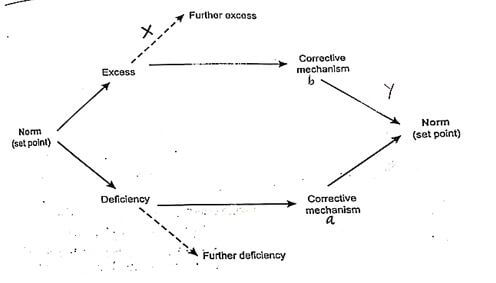
- Name the mechanism labeled X (1mark)
- If the above diagram represented temperature regulation.
- State the corrective mechanisms carried out at a (1marks)
- State the condition that may result from the further excess (1mark)

MARKING SCHEME
-
- State the contents of lysosomes. (1 mark)
Lytic enzymes - State the functions of the contents named in (a) above. (2 marks)
destroy aged and unwanted cell organelles; breakdown materials taken in by the cell eg. food substances and bacteria; sometimes destroy the entire cell.
- State the contents of lysosomes. (1 mark)
- What is cell specialization? (1mark)
the process by which newly formed cells undergo structural modification so as to perform specific functions - It was found that during germination of bean seeds, 9.2 cm3 of carbon IV Oxide was produced while 9.0 cm3 of oxygen was used up.
-
- Calculate the respiratory quotient of the reaction:- (2 marks)
RQ = volume of carbon(iv) oxide produced = 9.2cm3 = 1.022
volume of oxygen consumed 9.0
= 1; - Identify the substrate being metabolized. (1mark)
carbohydrates
- Calculate the respiratory quotient of the reaction:- (2 marks)
- In which part of the cell does glycolysis occur? (1 mark)
cytoplasm
-
- How is the tracheal system adapted to its function (3marks)
the spiracles are supplied with a muscular valve hat controls its opening and closing ; spiracles has hairs that help to prevent excessive loss of water from the body tissues by evaporation; the trachea consist of chitinous spiral bonds that keep them open to allow gases to pass through; the tracheoles ramify the body tissues of the insects for direct supply to individual cells; tracheoles lack the spiral chitinous bonds to permit gaseous exchange across their thin walls. - Name two sites where gaseous exchange takes place in terrestrial plants. (2marks)
stomata
lenticels - The experiment illustrated below was set up to investigate a certain physiological process using a raw potato tuber

- Suggest a possible physiological process that was being investigated. (1 mark)
osmosis - Explain the results obtained in the above experiment after a few hours (3 marks)
volume - the glucose solution increased while the volume of distilled water in the trough decrease; this is because of a concentration gradient that exists between the glucose solution and distilled water; and water moved to the glucose solution by osmosis. - State the observations that would have been made if the experiment was repeated using boiled potato. (2 marks)
there will be no observable change; since when the potato is boiled ; the cell membrane is destroyed and osmosis will not take place
- Suggest a possible physiological process that was being investigated. (1 mark)
- State the end products of anaerobic respiration in: - (2marks)
- Animals
lactic acid and energy - Plants
ethanol carbon (iv) oxide and energy;
rej; if not all are given
- Animals
- State two properties of the cell membrane (2marks)
semi-permeability
sensitivity to changes in temperature and ph
it is polarized (any 2) - State two guidelines that should be followed when typing of scientific names (2marks)
they should be typed in italics
the first letter of the genus name should be typed in capital letter and the species name written in small letters - State two roles of luteinising hormones in female reproduction. (2marks)
stimulates the maturation of the Graafian follicle
stimulates the remains of the Graafian follicle to form corpus luteum;
stimulates the corpus luteum to release - The diagram below shows a cross section of a plant stem.

- State the class of the plant from which the organ was obtained (1 mark)
monocotyledonae - Name the parts labeled X Y and Z (3 marks)
X epidermis
Y xylem
Z phloem
- State the class of the plant from which the organ was obtained (1 mark)
- What are the causative agents for the following sexually transmitted diseases? (2marks)
- Gonorrhoea
Neisseria gonorrhoea - Syphilis
Treponema pallidum
- Gonorrhoea
-
- What is meant by the following terms as used in ecology : (2marks)
- Population
refers to all members of a given species in a particular habitat at a particular time; eg, population of lions in Tsavo National Park in the month of June - Carrying capacity
Refers to the maximum number of organisms a given area can comfortably support without depletion of available resources; eg, the maximum number of cattle a paddock can hold without getting overgrazed.
- Population
- During an ecological visit to Maasai Mara students were able to see antelopes, lions, vultures, and pastoralists grazing their cattle. Construct a food chain with four consumer levels ending with the vulture to illustrate the energy flow in the ecosystem. (2marks)
Grass → Antelopes → Lion → Vulture;
acc. any other appropriate
- What is meant by the following terms as used in ecology : (2marks)
- Give three reasons why plants have not evolved complex excretory organs. (3marks)
plants limited physical activities leads to production of fewer wastes;
plants produce less toxic wastes
use diffusion to excrete gases and evaporation, transpiration and gulfation to eliminate water
store the waste products in organs which eventually fall off together with the waste products - State one adaptation of the xylem vessels to its functions. (1marks)
deposition of lignin in the vessels to prevent them from collapsing - State three factors that increases the rate of diffusion. (3 marks)
steep diffusion gradient
thinner membranes
high temperatures
large surface area
high surface area to volume ration
any 3 - The diagram below represents a certain plant, study it and answer the questions that follow

-
- Name the division to which the plant belongs (1marks)
bryophyta - The plant only survives in wet areas. Give a reason (1marks)
their fertilization depends on the availability of water
- Name the division to which the plant belongs (1marks)
- What is the function of part labeled A (1marks)
absorbs water and dissolved minerals salts
-
- Give the roles of each of the following important excretory products in plants (3marks)
- Quinine
used in the manufacture of drugs to treat ailments such as malaria - Colchicine
induce polyploidism in plants
used in genetics in plants and animal breeding research - Papain
contains a proteolytic substance used in the food industry as food tenderizer
- Quinine
- During a medical examination, a patient presented with the following symptoms, passing of large amounts of urine which when tested contained a lot of glucose.
- What hormone was deficient in the patient (1mark)
insulin - What disease was the patient suffering from (1mark)
diabetes mellitus
- What hormone was deficient in the patient (1mark)
- State three characteristic features used to classify members of phylum Arthropoda (3marks)
jointed appendages
body covered by chitin
segmented body
have bilateral symmetry - The graph below shows the effect of substrate concentration on the rate of enzyme reaction.

- Account for the shape of the graph between A and B (2marks)
there is increasing substrate concentration; resulting in an increased rate of enzymatic reaction - How can the rate of reaction be increased after point B? (1mark)
increasing the enzyme concentration - State one other factor that affects the rate of enzyme reaction. (1mark)
temperature ; pH.; enzyme co-factors and co-enzymes; enzyme inhibitors
- Account for the shape of the graph between A and B (2marks)
-
- The diagram below shows stage during cell division.

- Identify the stage of cell division in the diagram above (1 mark)
Anaphase I - Give a reason for your answer in (i) above (1mark)
homologous chromosomes separate and migrate to opposite poles with the centormeres leading
- Identify the stage of cell division in the diagram above (1 mark)
- How are the spongy mesophyll cells adapted to their functions? (1mark)
they are loosely arranged to create large air spaces providing spaces for gases to diffuse
- The diagram below shows stage during cell division.
- Name one cofactor and one co-enzyme required for a blood clotting process to be normal.
- Co-factor - calcium ions; acc Ca2+ (1mark)
- co-enzyme - vitamin K (1mark)
- Define the following terms; (2 marks)
- Taxonomy
the science of classification - Binomial nomenclature
is a system of naming in which an organism is given a name composed of two parts ; the first part is the genus and the second is the species
- Taxonomy
- In what ways do emotions affect the rate of breathing in humans (2marks)
emotions affect the production of hormone adrenaline; which increases the general metabolism hence increases the rate of breathing -
- Define the term predation (1 mark)
a feeding relationship in which an organism (predator) kills another organism (prey) for food - State three behavioral adaptations displayed by the prey to minimize predation (3mks)
mimicry ; for example the stick insect mimics a dry stick
confrontational display in porcupines
swift movement to escape predators
camouflage ; eg. in stripes of the zebra and spotted pattern of the giraffe
- Define the term predation (1 mark)
- Differentiate between the following terms:- (2marks)
- Hypogynous flower and epigenous flower
hypogynous flower is a flower whose other floral parts occur below the ovary; while epigenous flower is one in which the ovary is placed such that the other floral parts occur above the ovary - Gamopetalous corolla and polypetalous corolla
Gamopetalous corolla is one in which the petals are fused while polypetalous corolla is one in which the petals are free
- Hypogynous flower and epigenous flower
- Study the following chemical equation and answer the questions that follow

- Identify process x and the enzyme that catalyses’ the process (2mark)
process - hydrolysis; enzyme - hydrolase - Product Y (1mark)
glucose
- Identify process x and the enzyme that catalyses’ the process (2mark)
- Study the diagram below and answer the questions that follow.

- Name the mechanism labeled X (1mark)
positive feedback mechanism - If the above diagram represented temperature regulation.
- State the corrective mechanisms carried out at a (1marks)
no sweating/ hair raised/ blood kept from the surface/increased metabolism
any one - State the condition that may result from the further excess (1mark)
hyperthermia
- State the corrective mechanisms carried out at a (1marks)
- Name the mechanism labeled X (1mark)
Download Biology Paper 1 Pre Mock Questions and Answers - Mokasa I Joint Examination July 2021.
Tap Here to Download for 50/-
Get on WhatsApp for 50/-
Why download?
- ✔ To read offline at any time.
- ✔ To Print at your convenience
- ✔ Share Easily with Friends / Students

